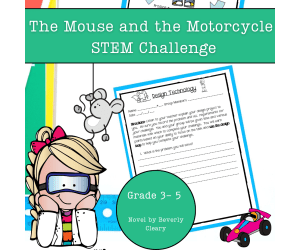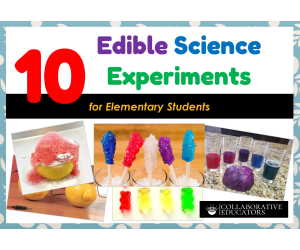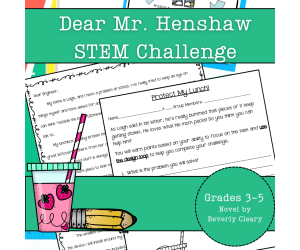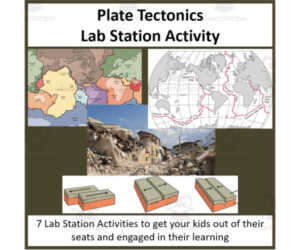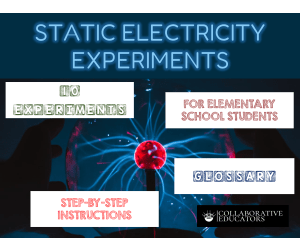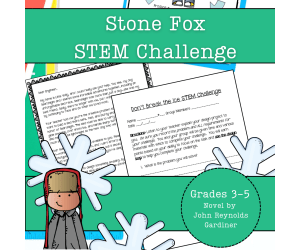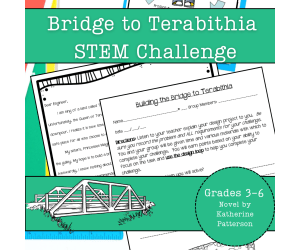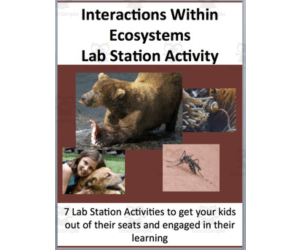2,789 products added recently
Science Experiments
Enhance your science curriculum with experiments that make learning interactive and engaging. This collection covers various scientific fields, including chemistry, physics, biology, and earth science. By integrating these science experiments into your lessons, you can inspire curiosity and deepen comprehension.
The Mouse and the Motorcycle STEM Experiment + STEM Project
Science, Technology, Engineering, STEM, Grade 3, 4, 5, Experiments, Activities, Projects, Diagrams, Teacher Tools, Graphic Organizers, Rubrics
Help design and build a four-wheeled car for Ralph, the adventurous mouse, from The Mouse and the Motorcycle. Perfect for integrating literature and science, this challenge guides students to apply engineering principles using simple materials while fostering teamwork and critical thinking. What’s Inside This Resource: Student Letter: A fun letter from Ralph introduces the challenge, linking the story to a real-world engineering task. Design Loop Graphic: A visual students can attach to their science journals, serving as a step-by-step guide throughout the activity. Detailed Instructions: Choose to print the guide as a packet or have students record each stage in their journals for an interactive experience. Teacher Tips: Practical guidance for crafting a clear problem statement with time constraints, materials, and success criteria tailored to your classroom. Skills Your Students Will Build: ✔ Problem-Solving: Identify obstacles and create inventive solutions. ✔ Engineering Design: Navigate the design loop—plan, construct, test, and refine. This page can easily be enlarged for a classroom poster. ✔ Critical Thinking: Assess their prototype’s performance and pinpoint ways to enhance it. ✔ Teamwork: Collaborate effectively to accomplish shared goals. Versatile Classroom Application: Whether as guided instruction or part of an integrated literature and science unit, this STEM activity encourages students to think creatively, document their process, and meet science and engineering standards. The rubric included is based on engineering concepts, but can also be used as a nonfiction writing rubric for cross-curricular options. Why Educators Love This Resource: ⭐ “My students were fully engaged, combining their passion for reading with STEM!” ⭐ “Simple to set up and encourages creativity and teamwork.” ⭐ “A seamless connection between literature and science for cross-curricular learning!” Inspire your students to solve Ralph’s problem and discover the joy of engineering with this fun, standards-aligned STEM challenge!
Author Kel's Klass
Tags 4th Grade Science Project, 4th Grade Science Experiment, 5th Grade Science Project, 5th Grade Science Experiment, Engineering Diagram, Science Graphic Organizer, Science Rubric, 3rd Grade Science Project, 3rd Grade Science Experiment, The Mouse And The Motorcycle
10 Edible Science Experiments for Elementary Students
Chemistry, Science, Grade 1, 2, 3, 4, 5, Labs, Experiments, Activities
Prepare yourselves for some incredibly entertaining science! "Edible Science Experiments for Elementary Explorers," this book, is your pass to a delicious journey. Do you wish to witness a rainbow that is (almost) edible? We have it. Consider creating enormous gummy bears. Simple as pie. You can even produce real butter and shake cream. That's cool, isn't it? There are ten incredible experiments within. You can find items in your kitchen for each one. The steps are quite easy. We give you detailed instructions. And you know what? The majority of the outcomes are yours to keep! You'll learn cool stuff too. Like why some liquids float and others sink. Or how mixing things can make bubbles. Science doesn't have to be boring. This book proves it! So grab your grown-up, put on your apron, and let's get started. You'll be a science whiz in no time. And you'll have some tasty treats along the way. It's science you can taste! Let the edible experiments begin!
Author Bright Classroom Ideas Marketplace
Rating
Tags Science, Chemistry, Lab, Elementary, Experiment
Science Action Labs Insects: Hands-On Science Activities Ready for Student Use
Science, Life Sciences, Insects, Grade 1, 2, 3, Labs, Experiments, Activities
Science Action Labs Insects: Hands-On Science Activities Ready for Student Use This interactive science activity kit offers a riveting method of teaching elementary students, specifically those in grades 1 through 3, about the fascinating world of insects. This comprehensive resource unravels various aspects about different insects and their life cycles under a simple yet informative light. Dynamic Learning Experience The unique experience integrates demonstrations and experiments into lessons. Activites include: Writing poetry about bugs Holding grasshopper jumping contests Constructing honeycombs from scratch Guide characters C.D., Allie, and Orbit are presented throughout for systematic knowledge acquisition that renders comprehension easier for young learners. A Teacher-Friendly Resource with Different Implementations This rich-resource comes packed with 64 printable pages tailored to beginner scientists' needs. It's an excellent tool for educators introducing insects at primary grade level either through individual study or group studies within classrooms. The buzzing environment at our feet opens up wonders beyond any storybook ever could relay about mother nature's intricate designs. Truly, the learning journey into the insect kingdom ties closely with fun for enhanced learner engagement together with Science Action Labs Insects teachings on these vital players in nature's ecological dance.</p
Author Classroom Complete Press
Tags Science Action Lab, Insects, Hands-on, Science Activities
Dear Mr. Henshaw STEM Experiment + STEM Project for Grades 3, 4, 5
Science, Technology, Engineering, STEM, Grade 3, 4, 5, Experiments, Activities, Projects, Diagrams, Teacher Tools, Graphic Organizers, Rubrics
Leigh Botts from Dear Mr. Henshaw needs your help! This STEM project encourages problem-solving as students plan and construct a device that will help protect Leigh's lunch from a sneaky thief. Perfect for blending literature with science, it allows students to explore engineering concepts using simple supplies while promoting teamwork and critical thinking. What’s Inside This Resource: Student Letter: A pleading letter from Leigh introduces the challenge, linking the story to a real-world engineering task. Design Loop Graphic: A visual students can attach to their science journals, serving as a step-by-step guide throughout the activity. Detailed Instructions: Choose to print the guide as a packet or have students record each stage in their journals for an interactive experience. Teacher Tips: Practical guidance for crafting a clear problem statement with time constraints, materials, and success criteria tailored to your classroom. Skills Your Students Will Build: ✔ Problem-Solving: Identify obstacles and create inventive solutions. ✔ Engineering Design: Navigate the design loop—plan, construct, test, and refine. This page can easily be enlarged for a classroom poster. ✔ Critical Thinking: Assess their prototype’s performance and pinpoint ways to enhance it. ✔ Teamwork: Collaborate effectively to accomplish shared goals. Versatile Classroom Application: Whether as guided instruction or part of an integrated literature and science unit, this STEM activity encourages students to think creatively, document their process, and meet science and engineering standards. The rubric included is based on engineering concepts, but can also be used as a nonfiction writing rubric for cross-curricular options. Why Educators Love This Resource: ⭐ “My students were fully engaged, combining their passion for reading with STEM!” ⭐ “Simple to set up and encourages creativity and teamwork.” ⭐ “A seamless connection between literature and science for cross-curricular learning!” Encourage your students to solve Leigh’s challenge and experience the excitement of engineering with this standards-aligned STEM adventure!
Author Kel's Klass
Tags 4th Grade Science Project, 4th Grade Science Experiment, 5th Grade Science Project, 5th Grade Science Experiment, Engineering Diagram, Science Graphic Organizer, Science Rubric, 3rd Grade Science Project, 3rd Grade Science Experiment, Dear Mr. Henshaw
Water Cycle Earth Science Activity
Earth and Environmental Sciences, Science, Earth Sciences, Environmental Science, Grade 2, 3, 4, Experiments, Activities, Diagrams, Teacher Tools, Lesson Plans, Templates
I created this water cycle science activity for young students who are beginning to learn how water moves through Earth’s systems. Each page focuses on a simple part of the water cycle, including evaporation, condensation, precipitation, and collection. The worksheets include clear diagrams, short explanations, and guided activities so students can understand the concept without feeling overwhelmed. This type of activity works well during science lessons, especially when students are being introduced to Earth science topics. It can be used as a whole-class activity, a science center, morning work, or extra practice after a lesson. I’ve used similar worksheets before, and students enjoy labeling diagrams and following the steps of the water cycle from start to finish. The pack is easy to print and works well in both color and black-and-white. It fits nicely into classroom routines and can also be used at home for review or reinforcement. What’s included: 11 printable water cycle worksheets Clear and simple water cycle diagrams Activities covering evaporation, condensation, precipitation, and collection Kid-friendly science illustrations Suitable for grades 1–3 Great for individual, partner, or small-group work
Author Bright Education
Rating
Tags Science, Water Cycle, Earth Science
GHS Pictogram Clipart – Glitter Design for Chemistry Classrooms & Craf
Common Core, Science, STEM, Chemistry, Physics, Life Sciences, Earth and Environmental Sciences, Technology, Basic Science, Resources for Teachers, Homeschool Templates, Homeschool Curriculum, Grade 10, 11, 12, Classroom Decor, Bulletin Boards, Posters, Teacher Tools, Word Walls, Door Decor, Experiments, Activities, Labs, Worksheets & Printables
GHS Pictogram Cliparts Glitter Design for Chemistry Classrooms, Crafts and Materials PNG If you’ve ever found the standard GHS (Globally Harmonized System) pictograms a bit too plain or uninspiring for your teaching materials, you’re not alone. That’s exactly why I decided to redesign them with a fresh twist. These 18 cliparts—9 in portrait and 9 in landscape format—combine the clarity of the official hazard symbols with a visually striking glitter effect. The colors remain true to the original system (red border, black symbol), but the glitter gives them a unique and eye-catching feel. I created each of these cliparts by hand in Procreate, with the classroom in mind. They’re still clearly recognizable as hazard pictograms, but they add a touch of design that fits beautifully into worksheets, posters, or digital resources. Ways you might use these in your classroom or materials: – Labeling chemical containers in a more engaging way – Gluing into student chemistry notebooks to support safety topics – Decorating posters or bulletin boards about lab safety rules – Enhancing worksheets or lab instructions visually – Adding to PowerPoint, Keynote, or Genially presentations – Integrating into digital learning platforms or safety training resources – Using them in flashcards for visual reinforcement Since you’ll receive both portrait and landscape versions (in PNG format with transparent backgrounds), you can easily adjust them to your layout or format. Whether you're printing or working digitally, the designs remain sharp and flexible. These glitter-style symbols were made to support safety awareness while also respecting visual design preferences—especially for teachers or students who appreciate a bit more flair in their materials. Usage rights: You may use the cliparts both privately and commercially within educational content, as long as your own contribution is clearly visible. Please do not resell the graphics individually. Wishing you lots of creativity while designing your materials, – Heike from @Lernfitness Did You Know? I teach with a certified therapy dog, and together we create a positive and welcoming learning environment. 🐶
Author Lernfitness
Rating
Tags Teaching Materials, Classroom Decorations, Decorative Elements, Cliparts, Illustrations, GHS, Science, Lab, Chemistry, Pictograms
Science Action Labs Astronomy
Science, Earth and Environmental Sciences, Space, Grade 1, 2, 3, Labs, Experiments, Activities
Science Action Labs Astronomy Eager to introduce your young learners to the captivating world of astronomy? Explore with them through our Science Action Labs Astronomy resource, designed ideally for Grades 1, 2, and 3. This dynamic educational tool boasts 64 ready-to-print pages in PDF format, perfect for activities geared towards nurturing their interest and understanding of astronomy. Use it in public schools or whilst homeschooling kids. Unravel the Vast Universe A primary focus polished within this resource is an evolving comprehension of the vastness of our universe. Students would develop insights on how crucial elements like rotation speed and gravity contribute to planetary movement within our solar system- all through exciting experimental learning! Cultural Learning and Historical Figures Weaved into these lessons are interesting folklore surrounding moon superstitions that have spanned cultures across time. We also highlight influential figures who made significant strides within astronomical science, connecting pupils with vibrant pieces of cosmic history. Creative Exploration & Hands-On Learning The resource fosters creativity by encouraging students to design their own Martian Being! On top of this engaging task comes hands-on rainbow-making activities that incorporate learning about chromatics. Evaluation & Cognitive Skill Building Built-in quizzes regularly evaluate progress while reconfirming comprehensive understanding. The interactive questionnaires extend student learning beyond textbook-style memorization - aiding cognitive skills development throughout the process. Versatile Usability Whether it's group classroom sessions, small group pairs or individual homework assignments - its flexible design fits seamlessly into any teaching environment. The product is more than just a teaching aid. It's an interactive, educational catalyst that sparks curiosity about space exploration, and fuels passions for discovery. Embrace the power of innovative learning with Science Action Labs Astronomy , as your pupils unravel mysteries of outer space right from their classrooms!
Author Classroom Complete Press
Tags Astronomers, Astronomy Activities, Science Labs, Action Labs, Astronauts In Space
Plate Tectonics – Lab Station Activity
Science, Earth and Environmental Sciences, Environmental Science, Grade 7, 8, 9, 10, Labs, Experiments, Activities
Plate Tectonics Lab Station Activity engages students through hands-on learning. This editable high school earth science resource teaches key concepts like tectonic plates, plate boundaries, earthquakes, major plates, seafloor spreading, and more. Students rotate through 9 stations, including: drawing models, conducting research, writing opinions, reading applicability passages, answering comprehension questions, watching expert video clips, creating their own multiple choice questions, and catching up on previous work. Bonus vocabulary puzzles ensure continued engagement. This activity works for whole group, small group, or independent work. The no-prep format means simply print, set up, and implement.
Author Teach With Fergy
Tags Earth, Plates, Continental, Earthquakes, Lab Station, Plate Tectonics Lab Worksheet Answer Key, Plate Tectonics Hands On Activity, Plate Tectonics Lab Answer Key, Hands-on Plate Tectonics Activities, Plate Tectonics Activity, Plate Tectonics Lab Answers, Plate Tectonics Activity Answer Key
Local Climate Action: Data-Driven Solutions for Teen Environmentalists
Earth and Environmental Sciences, Science, Earth Sciences, Environmental Science, Geology, Space, Life Sciences, Biology, Human Body, Nature & Plants, Homeschool Curriculum, Homeschool Templates, Grade 6, 9, 10, 11, 12, Lesson Plans, Teacher Tools, Workbooks, Worksheets & Printables, Centers, Activities, Experiments, Labs, Projects, Presentations
Equip and empower the next generation of climate leaders to act through data, tools, and projects that can be immediately applied in their own backyard. "Local Climate Action: Data-Driven Solutions for Teen Environmentalists" is a game-changing book that will empower high school students from climate observers to data-informed climate activists. This textbook written by Syed Hammad Rizvi connects climate knowledge around the world to practical solutions on a local level. By means of 45 chapters, teens are taught how to: Obtain and interpret local environment data with the help of easily accessible tools and sensors Integrate climate change impacts like urban heat islands, flood zones, or pollution hotspots Learn how to effectively disseminate your findings through the use of graphics, such as charts and Create and deliver youth-led projects on climate change that have tangible implications in the real world. Packed with practical examples, protocols, and ethics for a responsible climate response, this book turns classrooms and communities into living laboratories for climate resilience. It is a textbook and a toolkit that reaches beyond education by providing a means for empowerment and increasing awareness and knowledge for a climate-conscious population. Why Parents & Schools Love It: Practical and application-based: Goes beyond theory and projects that students can implement and have the potential for making a difference in the neighborhood community. This inculcates critical skills in data literacy, scientific inquiry, mapping, presentation, and project management skills which will benefit them in both school as well as in their future lives. Aligns with Curriculum: This can be easily incorporated into the curriculum of environmental science, geography, STEM education, and social studies. Youth Agency Enthusiast: This helps youth exercise leadership, representation, and partnership with the community for their benefit, enhancing their self-confidence. Engaging Youth Publication Lowdown Ethical & Inclusive: Emphasizes responsible data use, community science, & justice for our planet & our communities. Target Audience & Grade Level: Primary Audience: Grades: 9-12 Subjects: Environmental Science, Geography, STEM Education, Civics Education, Data Liter Target group: High school students, Eco-clubs, Project based learning initiatives, Homeschoolers, Climate advocacy groups for youths. Secondary Audience: Educators, Science Teachers, People involved in developing Curriculums. Those interested in Activity-based, ‘ Youth groups, libraries, and community centers running climate action projects. Copyright/Terms of Use This Book is copyrighted by Syed Hammad Rizvi. This material is intended only for personal and single-classroom use. This means you do not have the right to copy, distribute, and sell any part of this material. That is, you cannot place the material on the Internet where it could be downloaded by the public. If you want to share this resource among colleagues in your institution, you would need to purchase additional copies of this product through Teachsimple. Thank you for respecting this usage policy. This product has been shared among you happily by Syed Hammad Rizvi
Author Creative Book Store
Rating
Tags TeenEnvironmentalists, ClimateAction, DataLiteracy, STEMeducation, HighSchoolScience, ProjectBasedLearning, ClimateChangeEducation, YouthLeadership, EnvironmentalScience, TeacherResources
Easter Chemistry Bunting – Color, Decorate & Learn Chemical Elements
STEM, Science, Chemistry, Physics, Life Sciences, Biology, Grade 6, 7, 8, 9, 10, 11, 12, Activities, Worksheets & Printables, Banners, Classroom Decor, Bulletin Boards, Door Decor, Posters, Labs, Experiments, Drawing Templates & Outlines
Easter Chemistry Bunting A Creative Way to Learn the Periodic Table! 🐰🔬🎨 Every year, I like to add a bit of seasonal fun to my classroom. But instead of just decorating, why not make it educational too? That’s why I created this Easter-themed chemistry bunting—a simple but effective way to help students get familiar with the periodic table while being creative. Each pennant features an element’s symbol, name, and atomic number. Instead of memorizing, students color and decorate while naturally recognizing the elements they see every day. It’s low prep for you, fun for them, and adds a nice science-themed touch to your classroom! 🌟 What Makes This So Useful? ✔ Students are learning without even realizing it – They’ll see the elements daily, making them easier to remember. ✔ A great mix of science and creativity – Not just a decoration, but also an interactive classroom activity. ✔ No complicated prep – Just print, color, cut, and hang. ✔ Works for different ages – Ideal for chemistry, STEM, or general science. ✔ Perfect for individual or group work – Let students personalize their elements! 📌 What’s Included? 📜 127 Printable Pennants, featuring: ✔ All 118 main group elements ✔ Element name, symbol, and atomic number 🎨 Bonus: Extra Easter-Themed Pennants – Just for fun! 🖨 Black-and-White Format – Great for coloring and personalizing. 🎨 How to Use It 1️⃣ Print the pennants. 2️⃣ Let students color & decorate their element. 3️⃣ Cut them out and decide how to display them. 4️⃣ Hang them up – either as a bunting or pinned to the board. 💡 Try this: Assign each student an element and have them share one cool fact about it with the class! 🐣 Why Teachers Love It ✔ "I love that it gets students involved in decorating the classroom while reinforcing chemistry!" ✔ "They actually asked about elements while coloring – win-win!" ✔ "Easy to set up, fun, and looks great in my lab!" 🔬 A Simple Way to Make Chemistry Fun! Want to add some springtime energy to your science lessons without extra work? This bunting is an easy way to mix creativity with learning—perfect for chemistry labs, classrooms, and bulletin boards. 🚀 Print, color, and hang—it’s that easy! 📍 Best wishes, Heike from Lernfitness Did You Know? I teach with a certified therapy dog, and together we create a positive and inspiring learning environment. 🐶✨
Author Lernfitness
Tags Chemistry, Lab, Biology, Laboratory Equipment, Lab Tools, Physics, Bunting, Pennant Banner, Classroom Banner, Chemical Elements
Static Electricity Experiments for Elementary School
Physics, Science, Grade 1, 2, 3, 4, 5, Labs, Experiments, Activities
What is electrostatics, or static electricity? The buildup of electric charge on an object's surface is called static electricity, or electrostatics. This charge, which can be either positive or negative, is produced when a material's atoms acquire or lose electrons. When two objects rub against one another, electrons are transferred from one to the other, creating this static energy. As a result, one of the materials has a negative charge due to an excess of electrons, while the other material has a positive charge due to a lack of electrons. The feeling of a tiny electric shock after stepping on a rug and then contacting a metal surface is a typical example. Ten extremely basic and doable experiments that use or create static electricity are included in this useful e-book. Every experiment is safe and may be carried out using normal, commonplace items. Every experiment has comprehensive, step-by-step instructions. Lastly, each experiment is given a brief explanation so that elementary school pupils can understand it. Have fun exploring the marvels of static electricity through experimentation!
Author Bright Classroom Ideas Marketplace
Rating
Tags Static, Electricity, Experiment, Elementary, Science, Physics
Science Action Labs Animal Science: Active Science About Animals
Science, Life Sciences, Animals, Grade 4, 5, 6, 7, 8, Labs, Experiments, Activities
Science Action Labs Animal Science: Active Science About Animals This top-notch teaching aid is targeted towards Grades 4 to Grade 8. It focuses on subjects like science and zoology, with intriguing exploration at the core of its approach. The resource comprises a single PDF file featuring 64 ready-to-print pages for expedient preparation by educators. Each page aims to deepen students' understanding of various aspects of animal science making it an ideal part of any curriculum focusing on Zoology. The versatility of the material allows you to adapt it according to your teaching strategy - be it whole-group sessions or small group collaborations, ensuring seamless integration across different pedagogical methods. You can simulate animal habitats within your classrooms using hands-on explorations laid out in this versatile document. There's scope for learners' active engagement with interesting fish experiments that are sure to feed their curiosity and foster scientific temperaments. Create Their Own Creature! Your students can harness their creative power when asked to conceive their very own creature during lessons! Feel free to assign these as homework - individual assignments not only consolidate understanding but also enhance personal problem-solving skills amongst students, moulding them into budding scientists! A Comprehensive Learning Aid: This educational tool comes packed with comprehensive learning concepts, crisply explained across a myriad topics surrounding animals such as habitats, ecosystem balances or characteristics etc. This gives you an effective method for disseminating knowledge about animals' lives and the crucial roles they play in sustaining life on earth. In Conclusion: In essence, the Science Action Labs Animal Science: Active Science About Animals is more than just another academic worksheet set – it ignites learner engagement through Darwinian exploration! Such compelling features make these user-friendly yet rigorous academic worksheets an indispensable resource for any educator who values high-quality educational supplements.
Author Classroom Complete Press
Tags Animal Science, Action Labs, Super Animals, Animal Habitats, Earthworm Lab
Static Electricity – Lab Station Activity
Science, Physics, Grade 7, 8, 9, 10, Labs, Experiments, Activities
Static Electricity Lab Station Activity Bring static electricity concepts to life in your middle or high school science classroom. This interactive lab station activity allows students to engage with key physics concepts surrounding electrostatics, charging, and static electricity applications. Through nine unique stations, learners will conduct hands-on experiments, read applicability passages, watch expert videos, and more. The activity is designed to complement static electricity curriculum for grades 7-10. It requires almost no prep and includes detailed student sheets and answer keys. Extension activities like word scrambles and searches are also provided to maximize student engagement. Use this time-saving resource to create an immersive learning experience that will spark students' curiosity about the invisible world of static electricity.
Author Teach With Fergy
Tags Static, Electricity, Current, Charged, Lab Station, Static Lab, Electricity Activity, Static Electricity Activities, Static Word Scramble, Electrostatics Physics Lab Answers, Electricity Lab
Energy and its forms – Lab Station Activity
Science, Physics, Grade 8, 9, 10, 11, Labs, Experiments, Activities
Energy and its forms – Lab Station Activity is an immersive learning experience designed to demystify the complex world of energy, its types, sources, and transformations. A blend of science education and kinetic learning allows students to garner knowledge through hands-on activities. Each lab station has unique descriptions with some having intricate instructions to test knowledge comprehension. The provided 'passport' or recording sheet enables students to record their answers for assessment. Topics Covered: Different Types of Energy Understand Convection, Conduction & Radiation The origin of Everyday Energy Use In-depth Insights into Electricity Generation All about Thermodynamics- heat & temperature introduction for eighth graders! Bonus Activities Included: An engaging ten word scramble game and a word-search challenge designed for different learning abilities while maintaining high pedagogical momentum. This product uses innovative educational techniques like integrating diverse formats at each 'learning station'. These opportunities include creative tasks like model building related to the discussion topics; research-based quests; writing assignments; multiple-choice questionnaires supplemented by reasoning ability checks among other challenges inspired by reading materials. All aim at fostering the development of critical thinking skills in learners. In-built Rest Stations: Rejuvenating spots intended either as recuperation areas between station hops or revisiting previously covered material catered flexibility inside classrooms while considering students’ varying pace & focus levels simultaneously. This comprehensive lab activity serves as an excellent teaching aid that brings authenticity and excitement into science education - suitable not only as a regular lab activity but also doubles effectively as preparatory review methods prior exams or quizzes. Complete Package includes: Applicability Reading Lab Station Cards Lab Station Passport "Learn from the Expert" "Test Your Knowledge" sessions Bonus: Additional Answer Keys
Author Teach With Fergy
Tags Energy Types, Lab Activity, Science Education, Hands-on Learning, Critical Thinking
Apple Science Experiment - Observing Apples
Fall, Seasons, Holiday & Seasonal, Basic Science, Science, Nature & Plants, Life Sciences, Kindergarten, Preschool, Grade 1, 2, Experiments, Activities
Make learning about apples fun with this apple science experiment. Students will practice making predictions, conducting an experiment, and recording their results with this apple observation experiment. What is Included: There is a detailed instructional page that provides detailed instructions for the experiment, a materials list needed, and any special tips or optional activities to complete with this experiment. There is a recording page with easy to follow directions for students to draw or color their predictions and record the results of the experiment. There are two journaling pages students can use to record their results and write about what they observed during the experiment. One journal page includes picture clues to guide students in their responses, while the other is a simple journal page for students to draw whatever they wish and then write their responses. What is the Experiment? This experiment is an apple observation. An apple will be cut into fourths and placed in different environments for students to observe what happens to the apple slices after a set period of time. This experiment allows students to observe the oxidation process in an apple. How to Use: Students can work in small groups of 2 or 3 to complete this experiment. The teacher may also choose to lead the experiment with the whole group of students. Each method allows students to make predictions and record results on their own. This science experiment is perfect for young learners. The easy to follow instructions and scaffolded recording and journaling pages help students through completing the experiment. While setting up the experiment does take material and time to do, the recording pages and journaling pages are no-prep, making this an easy activity to prepare for students. The low prep experiment is a great addition to any busy classroom or home school environment.
Author The Connett Connection
Rating
Tags Apple Science, Apple Science Experiments, Science Experiment, Elementary Science, 1st Grade Science Experiments, Kindergarten Experiments, Kindergarten Science Projects, Science Experiments For Kids
Anatomy and Physiology Labs ~ Full Year Bundle
Science, Life Sciences, Human Body, Grade 9, 10, 11, 12, Labs, Experiments, Activities
This bundled package includes all the lab activities I use in my Anatomy & Physiology class. Many of these labs can also be used in a Biology course. Included in this package are 19 different labs, with guidelines, materials lists, and answer keys included. These labs are great for any level student from English Learner - EL - to more advanced students.
Author The Teacher Team
Tags Anatomy, Physiology, A & P, Anatomy Labs, Labs, Human Physiology Lab Ideas
Stone Fox STEM Experiment + STEM Project for Grades 3, 4, 5
Science, Technology, Engineering, STEM, Grade 3, 4, 5, Experiments, Activities, Projects, Diagrams, Teacher Tools, Graphic Organizers, Rubrics
Little Willy is looking for a way to build a sled that will honor Searchlight, in this STEM project inspired by Stone Fox. This science project encourages problem-solving as students plan and construct a sled that will be able to carry Willy safely across a block of ice. Perfect for blending literature with science, it allows students to explore engineering concepts using simple supplies while promoting teamwork and critical thinking. What’s Inside This Resource: Student Letter: A heartfelt letter from Little Willy introduces the challenge, linking the story to a real-world engineering task. Design Loop Graphic: A visual students can attach to their science journals, serving as a step-by-step guide throughout the activity. Detailed Instructions: Choose to print the guide as a packet or have students record each stage in their journals for an interactive experience. Teacher Tips: Practical guidance for crafting a clear problem statement with time constraints, materials, and success criteria tailored to your classroom. Skills Your Students Will Build: ✔ Problem-Solving: Identify obstacles and create inventive solutions. ✔ Engineering Design: Navigate the design loop—plan, construct, test, and refine. This page can easily be enlarged for a classroom poster. ✔ Critical Thinking: Assess their prototype’s performance and pinpoint ways to enhance it. ✔ Teamwork: Collaborate effectively to accomplish shared goals. Versatile Classroom Application: Whether as guided instruction or part of an integrated literature and science unit, this STEM science project encourages students to think creatively, document their process, and meet science and engineering standards. The rubric included is based on engineering concepts, but can also be used as a nonfiction writing rubric for cross-curricular options. Why Educators Love This Resource: ⭐ “My students were fully engaged, combining their passion for reading with STEM!” ⭐ “Simple to set up and encourages creativity and teamwork.” ⭐ “A seamless connection between literature and science for cross-curricular learning!” Encourage your students to help Little Willy achieve his goals and experience the excitement of engineering with this standards-aligned STEM adventure!
Author Kel's Klass
Tags 4th Grade Science Project, 4th Grade Science Experiment, 5th Grade Science Project, 5th Grade Science Experiment, Engineering Diagram, Science Graphic Organizer, Science Rubric, 3rd Grade Science Project, 3rd Grade Science Experiment, Stone Fox
Easter Chemistry Bunting - Learn Chemical Elements with Festive Banner
STEM, Science, Chemistry, Physics, Life Sciences, Biology, Grade 6, 7, 8, 9, 10, 11, 12, Activities, Worksheets & Printables, Banners, Classroom Decor, Bulletin Boards, Door Decor, Posters, Word Walls, Labs, Experiments
Easter Chemistry Bunting A Fun & Educational Decoration for Your Science Classroom! 🐰🔬 I love decorating my classroom for different seasons, but I also want my decorations to be educational and useful. That’s why I created this Easter Chemistry Bunting—it brings a bit of spring energy into the classroom while helping students get familiar with the periodic table! Each pennant features an element symbol, name, and atomic number, so students see and recognize them every day—without even thinking about it. It’s such a simple way to reinforce learning while brightening up the room! 🌸 Why This Works So Well in Class ✔ No extra work for you – Just print, cut, and hang. ✔ Students see chemistry every day – Without pressure, they start recognizing elements naturally. ✔ Festive, but not distracting – A bit of color and seasonal fun, while still focused on learning. ✔ Perfect for any science room – Whether in a chemistry class, lab, or hallway, it works anywhere. ✔ Easy to use in lessons – You can even make it interactive with a classroom game! 📌 What’s Included? 📜 127 Printable Pennants – One for each element, showing: ✔ Symbol ✔ Name ✔ Atomic Number 🎨 Colorful, Easter-Themed Designs – Cheerful and bright, but still focused on learning. 🖨 Easy to Print & Adjust – Scale it to fit your classroom space. 📎 Two Hanging Options: ✔ String them together for a banner. ✔ Attach with fasteners for a flexible display. 💡 Ideas for Using It in Class 1️⃣ Print and cut the pennants. 2️⃣ Hang them up in your classroom, hallway, or science lab. 3️⃣ Use them for a quick challenge – Call out an atomic number, and students find the right pennant! 💡 Another idea: Assign an element to each student and have them share a fun fact about it. 🐣 Why Other Teachers Like It ✔ “Students actually look at it and ask about elements—great conversation starter!” ✔ “A simple way to make the classroom feel more engaging.” ✔ “No prep, looks great, and makes chemistry more visible every day.” 🔬 Bring Chemistry into Your Easter Decorations! Instead of just hanging up generic classroom decorations, why not make them meaningful? This bunting adds a touch of spring while keeping students engaged with science. 🚀 Try it out and see how it works in your classroom! 📍 Best wishes, Heike from Lernfitness Did You Know? I teach with a certified therapy dog, and together we create a positive and inspiring learning environment. 🐶✨
Author Lernfitness
Tags Chemistry, Lab, Biology, Laboratory Equipment, Lab Tools, Physics, Bunting, Pennant Banner, Classroom Banner, Chemical Elements
Hearing and the Human Ear – Lab Station Activity
Science, Life Sciences, Human Body, Grade 7, 8, 9, 10, Labs, Experiments, Activities
Hearing and the Human Ear – Lab Station Activity : An Engaging Teaching Resource 📌Interactive resource: This activity offers interactive lab stations that keep students engaged and involved in their learning process. It's a refreshing shift from traditional methods of instruction. 📌Versatile application: This station-based activity can be used for classroom sessions, homeschooling, small study groups, individual assignments or even as supplemental homework tasks. Suitable for Grades 7 to 10. 📌Multifaceted learning approaches: Students get involved in varied tasks at each station such as conducting research using devices, writing their opinions or answering questions related to short videos. Leveraging Creativity & Understanding Real-Life Applications Drawing activities nurture creativity amongst learners. Crafting multiple-choice questions makes learning an interactive exchange. "Apply reading" sections help understand real-life situations around hearing loss and vertigo. Bonus Activities & Answer Keys For seamless Transitions In between transitions, bonus activities provide consistent engagement. Stronger classes can enjoy word scramble games whereas weaker ones can stay productive with a simple word search game. All Cards come with comprehensive answer keys easing educators' evaluation process! No Prep Required! Just Print & Place The Cards' Apart from core content around human hearing - educators also have the freedom to introduce additional biology related themes as broad as Energy Flow In Ecosystems and as specialized topics like Mitosis or Cancer Cell Division making it an infinite source of knowledge extension paths. The Hearing and the Human Ear – Lab Station Activity not only provides factual content on a central theme but ensures fun learning experience akin to mini field trips while in a classroom or at home.
Author Teach With Fergy
Tags Interactive Learning, Human Ear, Lab Activity, Station-based, Biology
Synthesis, Decomposition, and Combustion – Lab Station Activity
Science, Chemistry, Grade 7, 8, 9, 10, Labs, Experiments, Activities
Synthesis, Decomposition, and Combustion – Lab Station Activity Immerse your students in the fascinating world of chemistry using the Synthesis, Decomposition, and Combustion Lab Station Activity . This educational resource is perfect for teachers looking to actively engage their students in learning about the human digestive system . Designed specifically for grade 7-10 science and chemistry students. Interactive Learning Stations This interactive lab activity combines education with assessment. Your students journey through each of nine uniquely designed stations. Each station comes with a comprehensive description card that provokes discussions, challenging questions or creative tasks such as drawing or building artefacts relevant to digestion study. Simplicity at Its Best! One prime advantage for educators using this resource is its simplicity, requiring minimal preparation on your part. Just print and lay out the included descriptions cards before class. A Variety of Exciting Activities Variety offered by strategic exercises encourages self-learning. 'Rest station' allows learners reflection time between intense cognitive exercises. Bonus activities like exciting word scrambles ensure idle time is eliminated from your classroom. Note: You can use these lab-based learning resources either during actual lessons experimenting inside laboratory conditions or outside labs like review tasks before tests etc., Teachers have successfully employed these versatile tools within whole-group settings while others assign them as homework. In conclusion - With this thoroughly researched lab station activity on synthesis decomposition & combustion aspects of Human Digestive System hands-on illustrations insightful context reviews based games quizzes etc., expect strengthened understanding amongst children regarding organs disorders associated with digestion!
Author Teach With Fergy
Tags Chemistry Lab, Interactive Learning, Digestion, Synthesis, Decomposition
Human Digestive System – Lab Station Activity
Science, Life Sciences, Human Body, Grade 7, 8, 9, 10, Labs, Experiments, Activities
Human Digestive System – Lab Station Activity This interactive human digestive system resource engages students through eight diverse lab stations. Learners examine models, draw diagrams, watch videos, research online, solve puzzles, and respond to questions. The self-guided format enables customized implementation for individuals, small groups, or whole class. The non-repetitive blend of creativity, writing, media, and critical thinking caters to multiple learning styles. Students reinforce anatomy concepts like organs and disorders while connecting ideas to digestion processes. The activity concludes with an assessment where learners develop their own questions. Educators save prep time since the package provides content cards, recording sheets, and answer keys. Extendable to a unit on body systems.
Author Teach With Fergy
Tags Human, Digestive, System, Lab Station, Anatomy, Hands On Digestive System Activities, Digestive System Hands-on Activities, Digestive System High School Activities
Fats – Lab Station Activity
Science, Life Sciences, Biology, Grade 7, 8, 9, 10, Labs, Experiments, Activities
Fats – Lab Station Activity : An Innovative Learning Experience An immersive and interactive learning product for High School Biology students, Fats – Lab Station Activity offers a unique platform that advocates active learning about fats. This classroom resource stimulates pupil movement around the room fostering informed participation. The All-Inclusive Pedagogic Tool Caters to diverse learning needs: The resource employs varied strategies, posing exercises that require reading or viewing content ('visual/auditory learners'), answering from a thoughtful perspective ('creative thinkers'), etc. End-to-end understanding of fats: Our activity stations challenge pupils while acting as potent teaching instruments. Areas explored include types, uses & health impacts of fats and their properties. User-friendly for educators too: While richly detailed in its construct (hands-on projects at 'Station 1', research tasks at 'Station 2', application-oriented reading activities at 'Station 5', etc.), the product is easy to deploy - needing just printed cards arranged aptly! A practical boon included is an 'answer key', handy for cross-checks and effective student guidance. And yes - this isn't a rigid instrument but an editable one, capable of bespoke adaptations basis class dynamics! Bonus Task & Varied Instructional Scopes A bonus task is provisioned to entertain quick-finishing classes - an interplay with words relevant to the topic (like scramble/word search), aiding in knowledge reinforcement! The comprehensive format makes this material apt not just during whole group instruction but also during small group breakouts or even personalized home assignments! In conclusion: If you are on a lookout for tools linking high schoolers closely with biology fundamentals whilst stirring vibrancy in your classroom, Fats – Lab Station Activity could be your pick! Studying 'fats' needn't be boring - let interaction anchor knowledge!
Author Teach With Fergy
Tags Interactive Learning, Lab Activity, Biology, Fats, Critical Thinking
Bridge to Terabithia STEM Experiment + STEM Project for Grades 4, 5, 6
Science, Technology, Engineering, STEM, Grade 4, 5, 6, Experiments, Activities, Projects, Diagrams, Teacher Tools, Graphic Organizers, Rubrics
Bring literature to life with this exciting STEM activity inspired by Bridge to Terabithia! This challenge sparks creativity and problem-solving as students plan and construct a bridge for King Jesse as he plans to make entrance to Terabithia safer. Perfect for blending literature with science, it allows students to explore engineering concepts using simple supplies while promoting teamwork and critical thinking. What’s Inside This Resource: Student Letter: A letter from Jesse introduces the challenge, linking the story to a real-world engineering task. Design Loop Graphic: A visual students can attach to their science journals, serving as a step-by-step guide throughout the activity. Detailed Instructions: Choose to print the guide as a packet or have students record each stage in their journals for an interactive experience. Teacher Tips: Practical guidance for crafting a clear problem statement with time constraints, materials, and success criteria tailored to your classroom. Skills Your Students Will Build: ✔ Problem-Solving: Identify obstacles and create inventive solutions. ✔ Engineering Design: Navigate the design loop—plan, construct, test, and refine. This page can easily be enlarged for a classroom poster. ✔ Critical Thinking: Assess their prototype’s performance and pinpoint ways to enhance it. ✔ Teamwork: Collaborate effectively to accomplish shared goals. Versatile Classroom Application: Whether as guided instruction or part of an integrated literature and science unit, this STEM activity encourages students to think creatively, document their process, and meet science and engineering standards. The rubric included is based on engineering concepts, but can also be used as a nonfiction writing rubric for cross-curricular options. Why Educators Love This Resource: ⭐ “My students were fully engaged, combining their passion for reading with STEM!” ⭐ “Simple to set up and encourages creativity and teamwork.” ⭐ “A seamless connection between literature and science for cross-curricular learning!” Empower your students to solve Jesse’s challenge and experience the excitement of engineering with this standards-aligned STEM adventure!
Author Kel's Klass
Tags 4th Grade Science Project, 4th Grade Science Experiment, 5th Grade Science Project, 5th Grade Science Experiment, 6th Grade Science Project, 6th Grade Science Experiment, Engineering Diagram, Science Graphic Organizer, Science Rubric, Bridge To Terabithia
Interactions within ecosystems – Lab Station Activity
Science, Life Sciences, Biology, Grade 7, 8, 9, 10, Labs, Experiments, Activities
Interactions within Ecosystems – Lab Station Activity This science lab station activity enables students to explore biotic and abiotic factors that interact within an ecosystem. Learners will investigate concepts like symbiosis, limiting factors, exponential population growth, and predator-prey dynamics. The engaging lab stations feature creative hands-on tasks, research questions, opinion writing, applicability readings, knowledge checks, and video analysis. Students use a passport worksheet to record answers as they rotate through the self-guided stations at their own pace. This content can be used for in-class ecosystem labs or as a review before exams. Two bonus vocabulary building activities are also included to engage students. This activity covers core ecology standards and requires almost no teacher prep. Simply print and distribute the cards. An answer key is provided for applicable stations.
Author Teach With Fergy
Tags Ecosystems, Symbiosis, Predator, Lab Station, Activity































